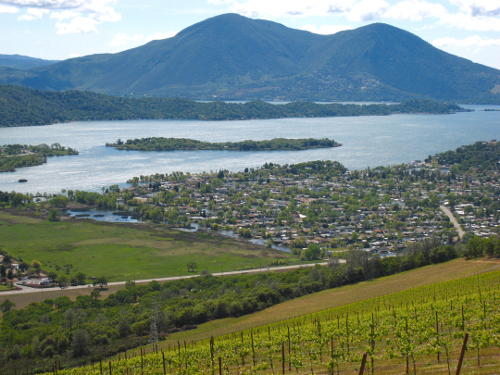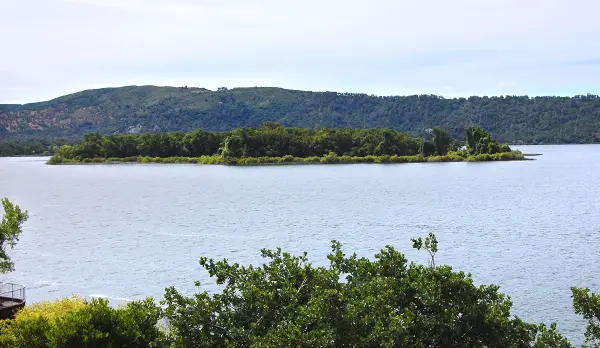
Islands are special places. Their uniquely precious web of life is also uniquely fragile, and can unravel at a touch.
Rattlesnake Island, situated a few hundred feet offshore in the Oaks Arm of Clear Lake and the lake’s largest island, is no exception.
Its habitat consists of mixed woodlands – willows, cottonwoods, and several species of oaks including some valley oaks (Quercus lobata) of truly majestic proportions – interlaced with grassy meadows spangled with wildflowers in the spring, and encircled by riparian vegetation consisting primarily of sedge-and-tule marshland.
Diverse flocks of water birds – dabbling and diving ducks, grebes, coots, cormorants, gulls, egrets, herons, etc. – visit the island and the surrounding waters.
It’s not uncommon to observe a swooping procession of several hundred white pelicans wheeling and turning overhead, or a resident osprey sallying forth from its perch on the shoreline to snatch a fish from the lake, while families of otter and the occasional mink can be seen cavorting along the shoreline.
The island is the anchoring landmark on the first of Lake County’s magnet “water trails” for kayakers and canoers, and the waters around it are widely considered to be among the best fishing locations on Clear Lake.
Rattlesnake Island is special for another reason as well. In the words of archaeologist Dr. John Parker, it “has been the political and religious center of the Elem Community of Southeastern Pomo for at least 6,000 years” – in other words far longer than Rome has been Roman, or Greece has been Greek.
During the fathomless span of years that they ate and drank, speared fish and gathered tules, chipped stone and wove baskets, fashioned boats and constructed houses, rejoiced in the newly born and mourned the newly dead, the record of those endless days of their lives accumulated.
Archaeologists have identified six specific sites there, dating back to the earliest human occupation of this hemisphere, but actually it would be more appropriate to consider the whole island as a priceless cultural heritage site, one of the most important in Lake County, in California or in the Western Hemisphere.
Befitting the immense antiquity of its continuous habitation, Rattlesnake Island has been determined eligible for inclusion on the National Register of Historic Places, and is listed on both the State Register of Historic Resources, and as a Sacred Site with the State Native American Heritage Commission.
As stated by Dr. Parker, “This island and its archaeological remains likely represent evidence of the oldest human use of the Clear Lake Basin ... The sites on Rattlesnake Island are in an excellent state of preservation and still contain the foundations of many of the prehistoric structures that have been built there.”
Despite ties that bind down the endless years, the Elem community no longer has legal title to its own Deep Home Place.
Rattlesnake Island was excluded from Elem trust lands in 1877, apparently by clerical error, and subsequently passed through a series of owners who put it to uses as various as a miners’ labor camp and a pig farm.
The current owner acquired it in 2003, with the intention of constructing a vacation home and several subsidiary structures on the site. Late in 2004 the county of Lake issued a permit for septic system (again apparently by clerical error), and most of the necessary excavation work was performed although the permit itself was subsequently rescinded; after extended tumultuous debate the Lake County Planning Commission then determined that due to the extremely sensitive nature of the site no project approvals could be granted before an environmental impact report was prepared.
There the matter rested until the spring of 2010, when county planning staff recommended that the Planning Commission approve a grading permit on the basis of an archaeological survey that several experts considered inadequate, and “mitigations” consisting primarily of a monitoring plan that was unlikely to prevent damage although sure to slow down the progress of the work and increase costs.
At the subsequent hearing, which took place on May 13, the commission heard more than four hours of testimony from the Sierra Club, the Heritage Commission, two archaeologists, an anthropologist, numerous impassioned tribal spokespersons, and several other members of the public, and then unanimously reconfirmed their earlier decision to require a focused a environmental impact report as a precondition for any project approvals.
Although restricted to an evaluation of cultural resources (suggestions to extend the evaluation to aesthetic and biological impacts were not accepted) limited to the specific locations subject to disturbance by construction or access roads, this decision nonetheless represents a major victory in the effort to protect one of Lake County's most precious treasures.
Perhaps even more significant in the long term, it may also provide the time that Elem’s leaders need to find the financial backing, from the federal government or other sources, needed to take back ownership of their ancestral homeland.
Victoria Brandon is a Board member of Tuleyome and was elected to the Sierra Club's Redwood Chapter Lake Group executive committee in 2004. She has been Group Chair since January 2005, mobilizing support for numerous campaigns other local conservation issues. She's also the secretary of the Chi Council for the Clear Lake Hitch, a participant in the Cache Creek Watershed Forum, a member of the Coalition for Responsible Agriculture, and the Lake County Peace Action newsletter editor.
Tuleyome is a local non-profit working to protect both our wild heritage and our agricultural heritage for future generations. Past Tuleyome Tales articles are available in the library section of the group's Web site, www.tuleyome.org.
Follow Lake County News on Twitter at http://twitter.com/LakeCoNews and on Facebook at http://www.facebook.com/pages/Lake-County-News/143156775604?ref=mf .
